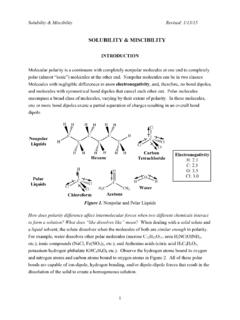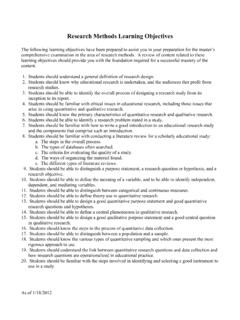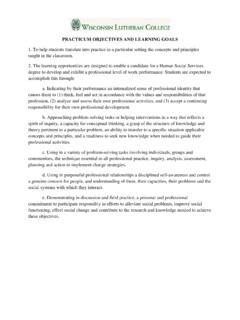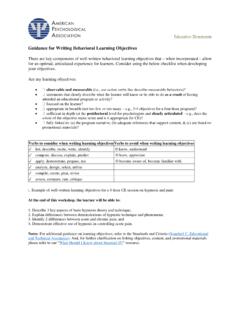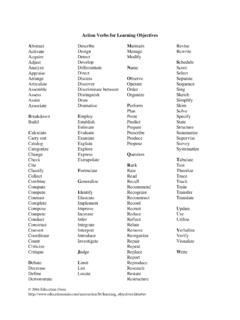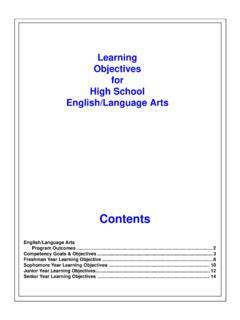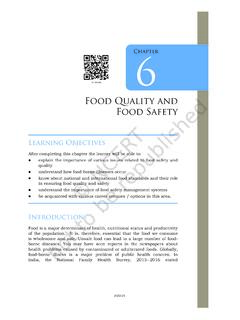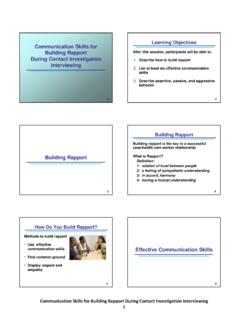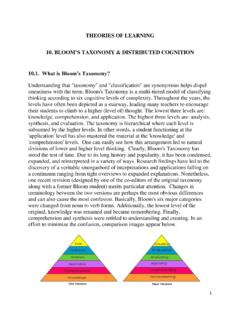Transcription of Writing learning objectives
1 Writing learning objectives 1 | Page Writing learning objectives This material was excerpted and adapted from the following web site: What is a learning objective? A learning objective answers the question: What is it that your students should be able to do at the end of the class session and course that they could not do before? A learning objective makes clear the intended learning outcome rather than what form the instruction will take. learning objectives focus on student performance. Action verbs that are specific, such as list, describe, report, compare, demonstrate, and analyze, should state the behaviors students will be expected to perform. Well-written learning objectives can give students precise statements of what is expected of them and provide guidelines for assessing student progress. Our goal for students is learning and if students don t know what they should be able to do at the end of class then it will be difficult for them to reach that goal.
2 Clearly defined objectives form the foundation for selecting appropriate content, learning activities, and assessment measures. If objectives of the course are not clearly understood by both instructor and students, if your learning activities do not relate to the objectives and the content that you think is important, then your methods of assessment, which are supposed to indicate to both learner and instructor how effective the learning and teaching process has been, will be at best misleading, and, at worst, irrelevant or unfair. Think about the lesson you will be teaching. What would you like for each student to know and be able to do when he/she has completed the lesson? learning objectives Specific statements describing what you and your students intend to achieve as a result of learning that occurs both in class and outside of class. They can be categorized in the following way: 1.
3 Cognitive objectives emphasize knowing, conceptualizing, comprehending, applying, synthesizing, and evaluating. These objectives deal with students knowledge of the subject matter, and how students demonstrate this knowledge. Writing learning objectives 2 | Page 2. Psychomotor objectives involve the physical skills and dexterity related to the instruction. Successful instruction involves teaching new skills or coordination of old ones ( , physical coordination involved in playing tennis or a musical instrument). Attitudinal objectives Specific statements about attitudes, values and emotions that students will have as a result of taking part in class activities. What learning objectives emphasize 1. learning objectives emphasize observed activity The only way you can determine whether or not a student has learned something is to observe some kind of behavior that indicates learning has taken place.
4 This behavior may range from correctly answering multiple-choice questions to requiring that the student actually demonstrate a skill. EXAMPLE Given a thesis statement in class, the student will write 3 topic sentences for paragraph development of the given statement. Instead The student will be able to write appropriate topic sentences for paragraph development of a thesis statement. EXAMPLE Given 4 theorems that he/she has never seen, the student will formulate a proof for each theorem by drawing on elements from previous sources and will rate them together to form a pattern proof with 80% accuracy. Instead The student will understand the concept of the Derivative. 2. learning objectives emphasize student activity Instructors sometimes state objectives in terms of their activities. However, learning objectives focus exclusively on student behaviors, not on the behaviors of the instructor.
5 EXAMPLE Given the necessary materials, the student will glue a black and white photo clipping from a magazine onto a 6x9 paper. The student will extend the black, white, and gray design of the photo to cover the area of the paper with a relevant design in class. Writing learning objectives 3 | Page Instead The student will be able to demonstrate understanding of color theory. EXAMPLE The student will listen to several letters read from the editorial page of a newspaper or magazine. He/she will participate in a discussion about the type of logic employed, the effectiveness of the evidence, and the validity of the argument. Instead The student will understand the processes of inductive and deductive reasoning. 3. learning objectives emphasize student outcomes Instructors often state objectives in terms of process or procedure while learning objectives refer to the end results of instruction.
6 A good learning objective states what a student will know or be able to do at the end of instruction. EXAMPLE Given a list of chemical compounds, the student will select 1 that is found at each step in the process of respiration and 1 that is found at each step in the process of photosynthesis. Instead The student will understand the fundamentals of respiration. EXAMPLE In class, the student will assign to each of 10 given statements 1 of the following terms: business ethics, ethics and the law, professional standards in business, and conflicts of interest; 70% accuracy. Instead of .. The student will examine the ethical conduct of American business. Advantages of using learning objectives The Writing of learning objectives focuses attention away from content and onto the students. This re-focusing often produces revisions in teaching methods.
7 1. Planning instruction: Once you have developed learning objectives for a course you can more rationally sequence instruction, allot time to topics, assemble materials, prepare outlines and booklists, etc. learning objectives can also be used as a guide to teaching, as when you plan different instructional methods for presenting various types of content based on the desired learning outcomes ( , small-group editing of reports to give students experience in evaluating content logic and correct usage). Writing learning objectives 4 | Page 2. Facilitating evaluation: learning objectives can facilitate various evaluation activities, evaluating students, evaluating instruction, evaluating the curriculum. They can form the basis for grading or for determining levels of competence in a mastery learning system. They can also be used to demonstrate effective teaching by matching student learning , as measured by exams, etc.
8 , to the desired outcomes. 3. Aiding in communication with others: There is a need to communicate learning objectives to others: between instructor and student, with other instructors. For example, exchanging learning objectives within departments is the most specific way to communicate to one's colleagues what you really cover in your course. 4. Improving instruction: If you intend to improve instruction in a particular lesson or course, you usually begin with the learning objectives for that lesson or course. 5. Producing new insights: The process of clarifying objectives may produce major changes in those who engage in the effort. For example, instructors who spend time developing learning objectives are said to acquire increased understanding about what is a feasible goal. When more general goals are explicitly identified, many specific sub-goals emerge.
9 Since it may not be possible to reach all the sub-goals, a hierarchy or "trade-off system" of goals must be produced. Writing learning objectives using Bloom's Taxonomy Bloom s Taxonomy of the cognitive domain, or thinking skills, can be helpful in constructing course learning objectives . Bloom and colleagues found that over 95% of exam questions required students to activate low-level thinking skills such as recall (1956). In addition, research has shown that students remember more content when they have learned a topic through higher thinking skills such as application or evaluation. Bloom s Taxonomy is a hierarchy of six cognitive skills arranged from less to more complex. Writing learning objectives 5 | Page Knowledge Recognizes students ability to use rote memorization and recall certain facts. Action verbs to help write objectives or exam questions for this domain: cite, define, identify, label, list, match, name, recognize, reproduce, select, state.
10 EXAMPLE learning objectives Exam questions The students will recall the four major food groups without error. Name the four major food groups. The students will list at least three characteristics peculiar to the Cubist movement. List three characteristics that are unique to the Cubist movement. The students will be able to define gram-positive bacteria. Define gram-positive bacteria. Comprehension Involves students ability to read course content, understand and interpret important information and put other s ideas into their own words. Writing learning objectives 6 | Page Action verbs to help write objectives or exam questions for this domain: classify, convert, describe, distinguish between, explain, extend, give examples, illustrate, interpret, paraphrase, summarize, translate. EXAMPLE learning objectives Exam questions The students will summarize the main events of a story in grammatically correct English.




